
Unpacking The Mystery: Why Are Dogs Scared Of Vacuums?

credit: depositphotos
Are you tired of your furry friend running away from the vacuum cleaner every time you clean your home?
As a dog owner, you may have noticed that many dogs seem to be scared of vacuums. The sound and movement of the machine can cause anxiety in dogs, leading to stress and fear.
Dogs are often scared of vacuums due to the strong vibrations and loud noise that they produce.
These sudden and unexpected sensations startle most dogs and trigger their instinct to flee from the perceived threat.
In addition, vacuums move erratically across the floor, which can be confusing for dogs who do not understand that their owners are controlling the movement.
As a result, many dogs will try to get away from the vacuum or even try to protect their owners from it.
In this blog post, we will take an in-depth look at why dogs are afraid of vacuums, signs that indicate your dog is scared, and how you can help them overcome their fear through desensitization and counterconditioning techniques.
We will also cover topics such as why dogs may be scared of brooms too, precautions to take when vacuuming around dogs, and the best vacuums for cleaning up pet hair and dander.
So let’s unpack the mystery behind why dogs are scared of vacuums!
The Root Cause Of Dog’s Fear Of Vacuums

credit: depositphotos
Similar to humans, dogs can have a natural fear of loud noises and unfamiliar objects. Vacuums, with their loud sounds and sudden movements, can be overwhelming and intimidating for dogs.
Dogs can be scared of vacuums, especially when encountering them for the first time. The loud noise and sudden movements can trigger their fight or flight response, causing them to bark, cower, or run away in fear.
It’s important to introduce your dog to the vacuum gradually and with positive reinforcement. When turning it on for the first time, make sure your dog is far from it and distracted.
Over time, they may become more comfortable with the vacuum and even associate it with positive experiences like treats or playtime.
Additionally, negative experiences with vacuums or exposure to others’ fear of vacuums can contribute to a dog’s fear.
It’s essential to understand these root causes to help desensitize your furry friend and reduce their fear over time through positive reinforcement training.
Signs That Your Dog Is Afraid Of Vacuums

credit: depositphotos
Dogs, like humans, can experience anxiety and fear in certain situations.
If your furry friend exhibits any signs of anxiety such as shaking, panting, or hiding when they see the vacuum cleaner, it is likely that they are afraid of it.
When a vacuum cleaner comes out, many dogs become scared and anxious. This is often noticed by changes in their body language such as lunging, barking, or other behavioral changes.
Dogs may be afraid of vacuums due to the loud noise they make or the unfamiliar movement of the machine.
It is important for pet parents to understand their dog’s fear and not force them to face it.
By gradually introducing the vacuum to the dog through positive reinforcement and observing their body language, pet owners can help ease their dog’s fear of vacuums.
Some dogs may become aggressive towards the machine, which can be dangerous for both them and their owners.
Fear of vacuums could be due to a traumatic experience in the past or simply because the sound and movement of the vacuum cleaner can be perceived as a threat.
It is important to understand these signs and take steps to help your dog overcome their fear to ensure their well-being.
Understanding The Different Types Of Vacuums
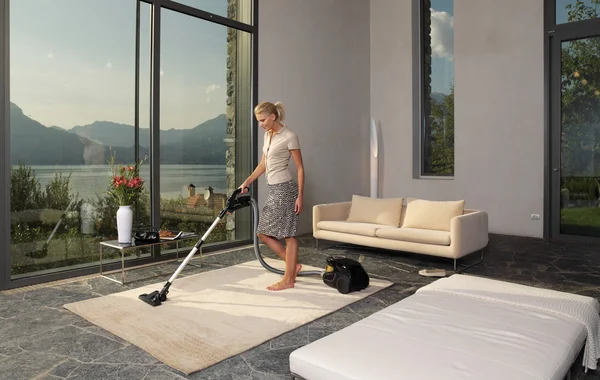
credit: depositphotos
When it comes to choosing a vacuum for your home, there are various types to consider.
Upright vacuums are great for deep cleaning carpets, while canister vacuums are versatile and can be used on both carpets and hard floors.
If you’re looking for a lightweight option for quick cleanups, a stick vacuum may be the way to go.
Handheld vacuums are perfect for small messes or hard-to-reach areas, and robotic vacuums offer convenience by automatically cleaning your floors while you’re away from home.
Dogs may be scared of vacuums, especially Roombas, due to the noise they make and their sudden movements.
In some cases, dogs may have had negative experiences with vacuums in the past, such as getting their tail caught or being accidentally hurt by the machine.
To help your dog cope with cleaning day, it is recommended to manage their environment while you work and potentially try a less noisy vacuum or a different style of vacuum altogether.
Many dogs are also scared of robot vacuums. The noise, movement, and unfamiliarity of the machine can be overwhelming for some dogs.
It’s important to supervise your dog whenever the robot is running and introduce them to it slowly and with positive reinforcement.
Noise desensitization techniques may also help in reducing fear related to the sounds of the vacuum. With patience and training, dogs can learn to associate vacuums with rewards rather than fear.
Understanding the different types of vacuums available can help you select the one that best suits your household’s needs.
Can Desensitization And Counterconditioning Help Your Dog?
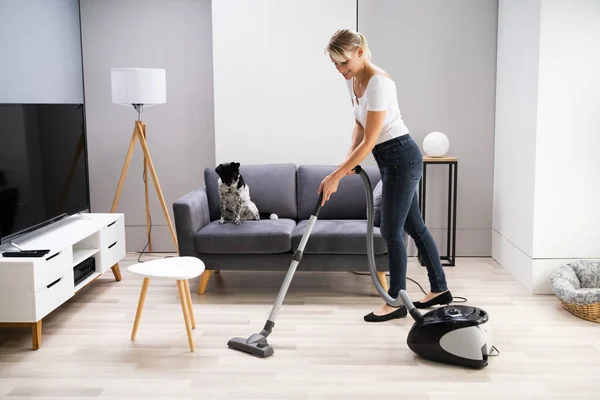
credit: depositphotos
If your dog is scared of vacuums, desensitization, and counterconditioning can be useful tools to help them overcome their fear.
Desensitization involves gradually exposing your pet to vacuum sounds and movements at a comfortable distance, while counterconditioning involves pairing the sound of the vacuum with positive experiences like treats or playtime to create a positive association.
These techniques, when used consistently and patiently, can help your dog develop a more relaxed attitude toward vacuums.
Seeking professional guidance from a certified dog trainer may also be beneficial in addressing your dog’s fear of vacuums.
Steps To Desensitize Your Dog To Vacuums
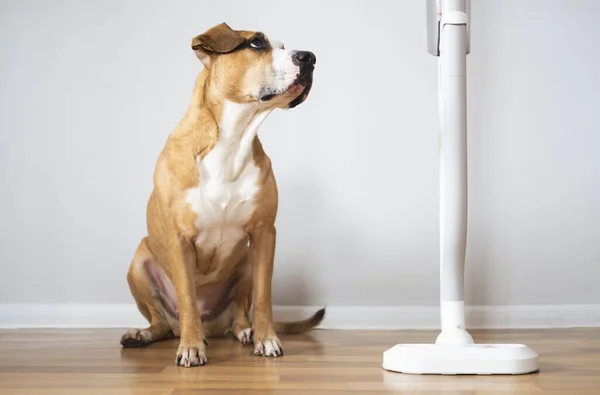
credit: depositphotos
Overcoming your dog’s fear of vacuums can be a challenging task, but desensitization can gradually help them feel more comfortable around these household devices.
The process involves gradually introducing the sound and presence of a vacuum to your dog while rewarding them for remaining calm.
Start by placing the vacuum in another room with the door closed and reward your dog with treats for not reacting.
As your dog becomes more relaxed, move the vacuum closer and eventually turn it on while continuing to reward them for their calm behavior.
Dogs are known to be sensitive to loud sounds, and vacuums definitely fall into that category. Dogs have a better hearing range than humans, meaning they can detect sounds at lower decibels than we can.
Vacuums often register around 75 dB, which is loud enough to cause discomfort for dogs. Quieter vacuums can help alleviate this fear by emitting lower decibels of sound.
Understanding a dog’s sensitivity to sound is key in training them to be more comfortable around household appliances like vacuums.
Consistency and patience are key when using this technique to help your furry friend feel at ease around vacuums.
Tips For Counterconditioning Your Dog
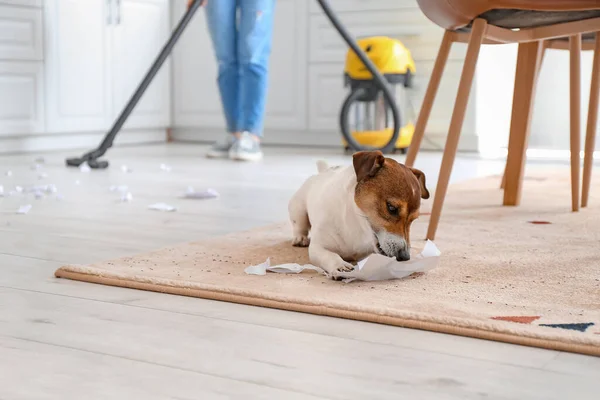
credit: depositphotos
Changing your dog’s emotional response to a scary stimulus, like a vacuum, is the aim of counterconditioning.
This process involves exposing your dog to the sound and presence of the vacuum along with something positive, such as treats or playtime, to create a positive association.
Dogs can be scared of vacuums due to the loud noise it produces and their sudden movements. To help your dog overcome this fear, you need to conduct a series of training sessions over a few weeks.
It is important not to rush the process and start from a distance that your dog feels comfortable with.
If your dog gets overwhelmed and starts reacting negatively, take a break and go back to a distance where your dog can be successful.
You can also consider enlisting the help of a professional dog trainer to make the training session more effective.
Gradually decreasing the distance between your dog and the vacuum while continuing to pair it with positive experiences is essential for success.
Remember to be patient and go at your dog’s pace – rushing can make things worse. Consistency is key – continue to practice regularly until your dog is comfortable around the vacuum.
What To Do When Your Dog Attacks The Vacuum Cleaner?
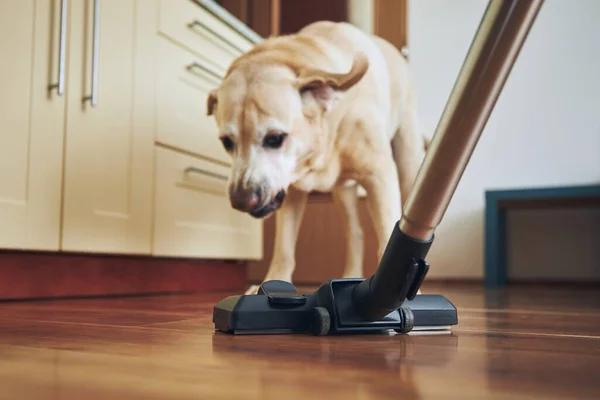
credit: depositphotos
It’s a common problem – your furry friend attacking the vacuum cleaner. But why do dogs react this way? Typically, it’s due to the noise and movement of the device.
However, that doesn’t make it any less frightening for our four-legged companions. The good news is that there are several strategies you can use to help your dog overcome their fear.
Gradual desensitization, obedience commands, and positive reinforcement can all be effective tools in redirecting your dog’s behavior.
Additionally, calming aids like pheromone sprays and anxiety-reducing supplements may also help ease their fears.
If your dog’s fear is severe or persistent, consider seeking professional help from a dog trainer or behaviorist.
Helping Your Puppy Overcome Its Fear Of Vacuums

credit: depositphotos
Introducing your puppy to the vacuum cleaner at an early age can help prevent the fear of vacuums from developing.
Gradual exposure, positive reinforcement, and desensitization training are all effective approaches for helping your puppy overcome its fear.
Understanding a dog’s body language is crucial to identifying if they are scared of vacuums.
Signs such as ears pinned back, tail tucked between legs, and excessive panting can indicate that a dog is uncomfortable or frightened.
It is important to train dogs to be more comfortable with the vacuum by gradually introducing it and using positive reinforcement techniques such as treats.
Remember to be patient and consistent in your training efforts, rewarding progress with treats or praise.
Seeking professional help may be necessary if your puppy’s fear is severe, but with time and effort, you can help your furry friend feel more comfortable around the vacuum.
Why Dogs Might Be Scared Of Brooms Too

credit: pixabay
Just like vacuums, brooms can also be a source of fear for dogs. This fear may stem from past negative experiences with brooms or the similarities between the sound and movement of brooms and vacuums.
Moreover, the high-pitched sound of a broom sweeping or hitting the floor can be uncomfortable for dogs’ sensitive ears, causing them to feel anxious or scared.
Additionally, some dogs may have a natural fear of unfamiliar objects or sounds, including brooms.
As a responsible pet owner, it’s crucial to understand your dog’s fears and work towards helping them overcome their anxiety towards these common household items.
Best Vacuums For Dog Hair And Dander
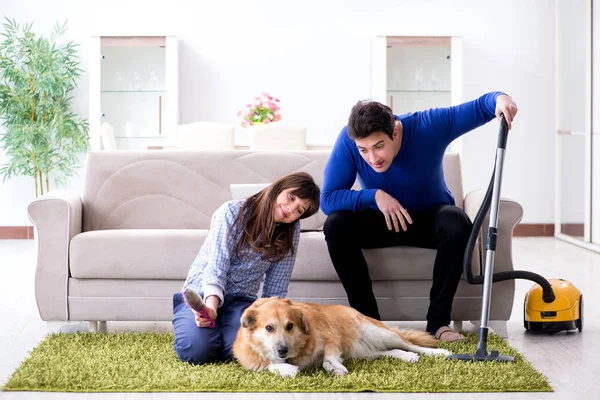
credit: depositphotos
When it comes to keeping your home clean and free from pet hair and dander, choosing the right vacuum is crucial.
The best vacuums for dog hair and dander are specifically designed to handle the unique challenges posed by pets.
Look for a vacuum with strong suction power and a high-quality filtration system to ensure that allergens are effectively trapped and removed from your home.
Additionally, consider the type of flooring in your home and look for a vacuum that is suitable for both carpets and hardwood floors.
With the right vacuum, you can keep your home clean and comfortable for both you and your furry friend.
Precautions To Take When Vacuuming Around Dogs
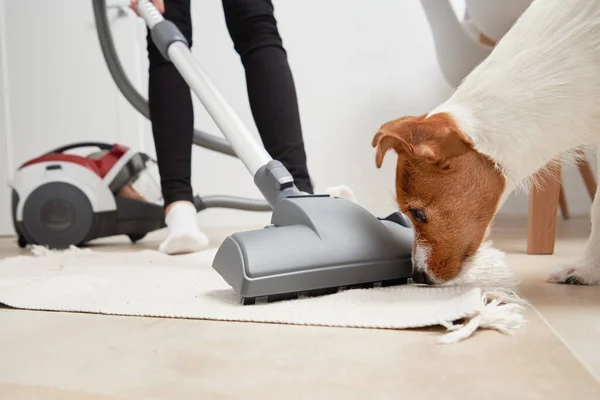
credit: depositphotos
When vacuuming around dogs, it’s important to take certain precautions to ensure their safety and comfort. One common problem that arises is dogs becoming fearful or anxious around the vacuum.
To avoid this, experts suggest gradually introducing your dog to the vacuum by allowing them to inspect it while turned off.
Once your dog becomes comfortable with the vacuum’s presence, you can slowly turn it on and use positive reinforcement techniques like treats or praise to encourage calm behavior.
Dogs can be scared of vacuums because they are loud and make a lot of noise. They also move around the house, making them unpredictable and scary for dogs.
Another reason why dogs are scared of vacuums could be because they associate it with being punished or scolded in the past.
To help your dog overcome this fear, you can try keeping the vacuum cleaner in another part of the house until you’re ready to start training or introduce your dog to the vacuum while it is turned off and making no noise.
Additionally, always supervise your dog when vacuuming to prevent accidents or injuries.
Addressing Other Pet Phobias
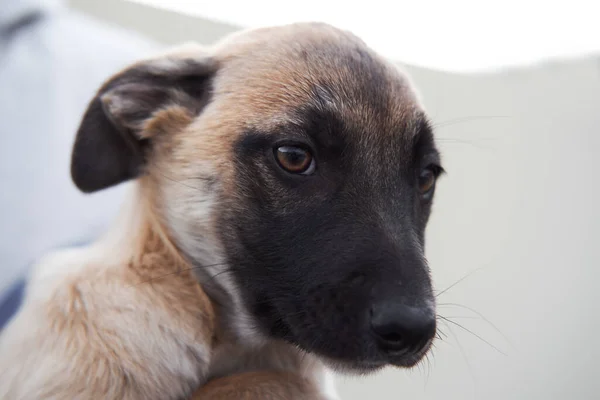
credit: depositphotos
Pets can develop phobias related to a wide range of stimuli, including loud noises, unfamiliar people or objects, and certain situations.
The root cause of these fears varies depending on the pet’s personality, breed, and past experiences.
Identifying common phobias in pets is the first step towards helping them overcome their anxieties. Providing a safe space for your pet or using calming aids can help ease anxiety in mild cases.
In more severe instances, seeking professional help may be necessary to address the underlying causes of pet phobias.
Frequently Asked Questions
1. Are all dogs scared of vacuums or only certain breeds?
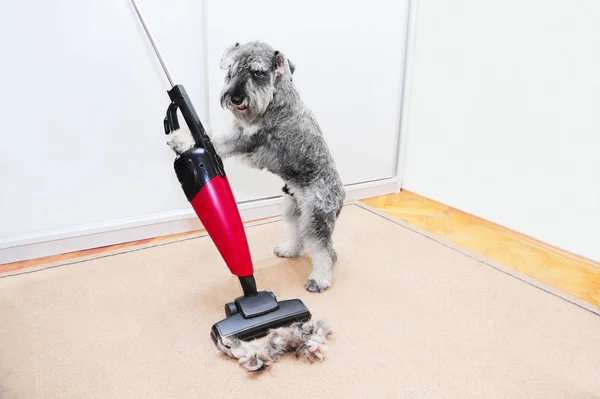
credit: depositphotos
Not all dogs are scared of vacuums, but it is a common fear among many breeds. Dogs that are more sensitive to loud noises or sudden movements may be more likely to be scared of vacuums.
Some breeds, such as Greyhounds and Whippets, have a natural instinct to chase small, fast-moving objects like vacuums. However, proper socialization and training can help reduce a dog’s fear of vacuums.
Adult dogs may develop a fear of vacuums due to their loud noise and sudden movements.
This fear can be overcome through desensitization training, which involves gradually introducing the vacuum to the dog in a non-threatening way.
Although it might be easier to train a puppy, it is not impossible to train an adult dog. A good technique is to have someone turn on the vacuum in another room while you comfort and praise your dog.
With patience and consistency, your adult dog can learn that the vacuum is not something to be scared of.
It is important to introduce your dog to the vacuum gradually and provide positive reinforcement for calm behavior around it.
With patience and consistency, most dogs can learn to tolerate or even ignore the vacuum.
2. What can I do to help my dog overcome their fear of vacuums?
If your dog is afraid of vacuums, gradual desensitization can help them overcome their fear. Start by exposing your dog to the vacuum from a distance and rewarding them for calm behavior.
Dogs may develop a fear of vacuums due to a bad experience with the machine.
This negative association could be caused by exposure to loud noise or sudden movement from the vacuum, which can be stressful for the dog’s ears and senses.
If a dog has been startled or scared by a vacuum cleaner, this can lead to a phobia over time.
It is important to introduce dogs to vacuums in a gradual and non-threatening way to prevent them from developing this fear.
Over time, gradually increase exposure and reward your dog for remaining calm until it can be near the vacuum without fear.
Positive reinforcement training techniques can also be helpful in this process, or you may want to consider seeking the help of a professional dog trainer who specializes in behavior modification.
With patience and consistency, your dog can learn to overcome their fear of vacuums.
3. Are there any training techniques or tips for helping a dog overcome its fear of vacuums?
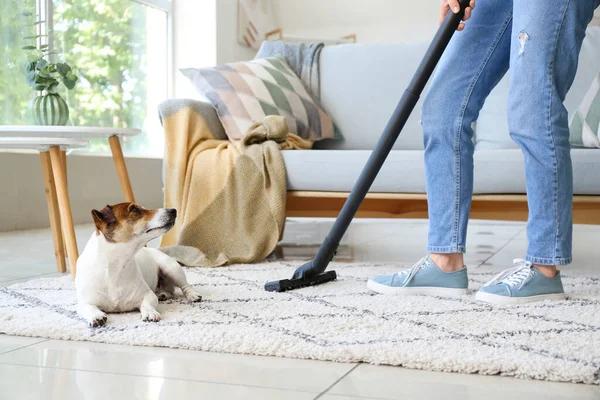
credit: depositphotos
There are several techniques and tips that can help a dog overcome their fear of vacuums.
Gradual exposure to the vacuum can help desensitize the dog and rewarding them with treats and praise for calm behavior around the vacuum can reinforce positive associations.
Positive reinforcement training techniques, such as clicker training, can also be effective in helping the dog associate positive feelings with the vacuum.
However, if the fear is severe, it may be best to seek professional help from a certified dog trainer or behaviorist.
4. What are some common reasons that dogs may be scared of vacuums?
Dogs can develop a phobia of vacuums due to the loud noise and sudden movements that the machine makes.
This fear can be intensified if the dog has had a negative experience with a vacuum in the past, such as accidentally getting too close to it or being hit by it.
The phobia can manifest itself in various ways, including shaking, hiding, or barking aggressively at the vacuum.
Owners can help their dogs overcome this fear by gradually exposing them to the vacuum in a positive and controlled manner.
There are several reasons why dogs may be scared of vacuums. The noise of the vacuum can be frightening to dogs due to their sensitive hearing.
Additionally, some dogs may perceive the movement of the vacuum as a threat or predator.
Dogs who have had negative experiences with vacuums in the past, such as getting accidentally sucked up or injured, may also be scared.
Finally, some dogs may simply not be familiar with vacuums and find them intimidating.
Another reason that dogs are scared of vacuums is because of the strong vibration and loud noise they produce. This sudden onset of noise can startle most dogs and make them feel threatened.
As dogs have a protective nature towards their owners, they might also feel the need to protect them from this “threatening” object moving around erratically.
Dogs might not realize that the owner is controlling the vacuum movement, which adds to their fear. It’s important to introduce dogs to vacuums slowly and train them to overcome their fear gradually.
It’s important to introduce your dog slowly to vacuums and provide positive reinforcement to help them feel more comfortable around them.
Conclusion
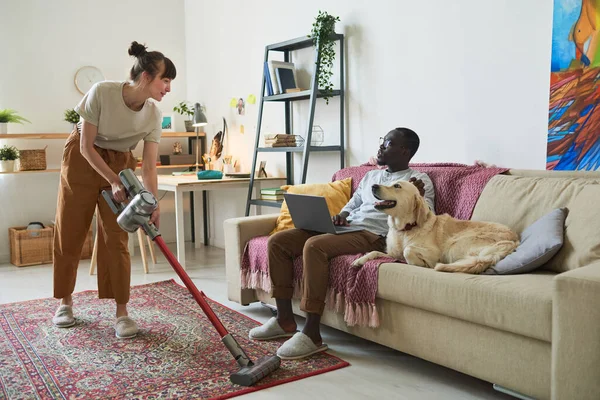
credit: depositphotos
In conclusion, understanding the root cause of your dog’s fear of vacuums is crucial in helping them overcome it. It could be due to the loud noise, strange movements, or the vacuum being viewed as a threat.
Desensitization and counterconditioning are effective methods to help your dog get comfortable with vacuums gradually.
Additionally, taking precautions such as introducing a quieter vacuum and ensuring your dog has a safe space while vacuuming can make a big difference.
If you are struggling with your pet’s phobias, check out our related articles on pet behavior and how to address them.
Related Articles
As a dog owner, it’s important to understand your furry friend’s behavior and know how to address their fears and phobias.
If your dog is scared of vacuums, they may have other common fears too, such as thunderstorms or fireworks.
Fortunately, there are several techniques that can help ease your dog’s anxiety, from gradual desensitization to positive reinforcement.
Understanding these methods can make a world of difference in keeping your pet happy and calm.
Keep reading for more information on how to help your dog overcome their fear of vacuums and other phobias.
- https://www.instagram.com/dogingtonpost/
- https://www.instagram.com/dogster/
- https://www.youtube.com/dogingtonpost
- https://www.youtube.com/user/AmericanKennelClub
- https://www.chewy.com/adaptil-electric-dog-diffuser-starter/dp/281827
- https://www.petmd.com/dog/training/why-are-dogs-scared-vacuums
- https://www.petmd.com/dog/behavior/timid-behaviors-dogs-are-they-normal
- https://vcahospitals.com/know-your-pet/signs-your-dog-is-stressed-and-how-to-relieve-it